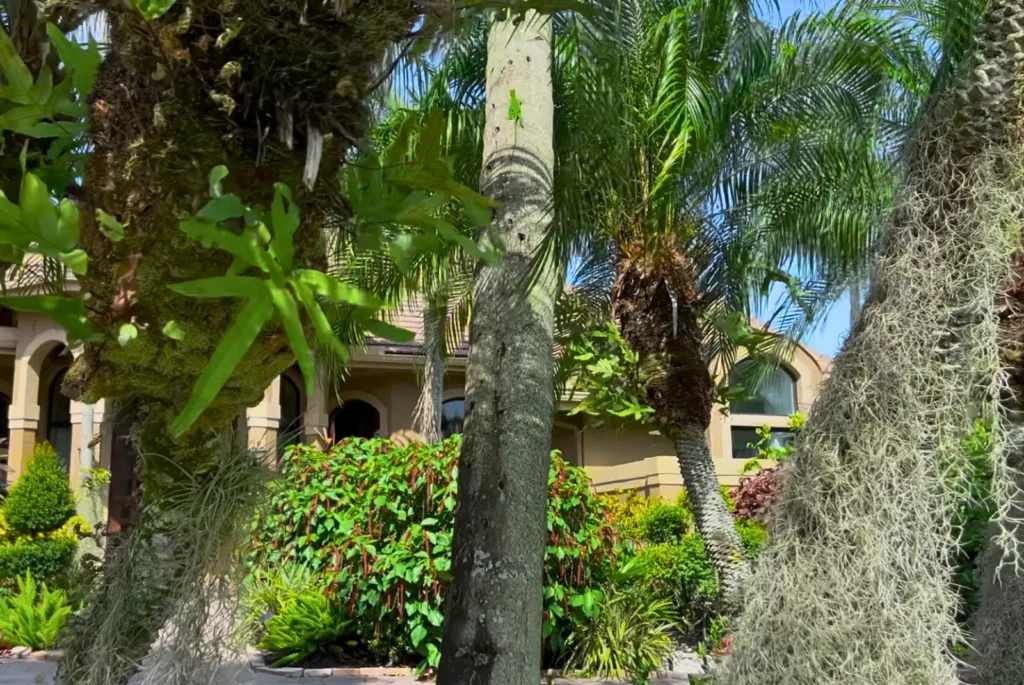What Happens to Florida Iguanas During a Hurricane?
Affiliate Disclosure: Some of the links on this page are affiliate links. This means if you click on a link and make a purchase, Dont Iguana may earn a small commission, at no extra cost to you. We only recommend products and tools we believe are helpful for keeping your Florida property iguana free!
If you’ve lived through a Florida hurricane, you know the routine. You bring in the patio furniture, fill up your gas tank, and start scanning the weather updates every hour. But while you’re prepping your house, there’s another group of locals quietly reacting to the storm in their own way: the iguanas.
These prehistoric looking reptiles seem like permanent fixtures in many Florida backyards. They bask in the sun, nibble on your landscaping, and occasionally drop in (literally) from trees. But when hurricane season hits, a question naturally comes up: What actually happens to iguanas during a hurricane?
Do they sense the storm before it arrives? Where do they hide once the winds pick up? And more importantly, what does all this mean for your yard? Whether you’re a long time homeowner or a new Floridian, understanding iguana behavior during extreme weather can help you protect your space, and stay one step ahead.
Do Iguanas Know When a Storm Is Coming?
You won’t see iguanas watching the Weather Channel, but they’re more tuned in than they look. Like many animals, they can sense changes in the environment, especially drops in barometric pressure and shifts in humidity. When these signals start stacking up, most iguanas stop their usual sunbathing routines and begin looking for shelter.
In the days leading up to a storm, you might notice fewer iguanas hanging around on fences or rooftops. Instead, they retreat to quieter areas, sometimes vanishing entirely until the weather clears. It’s not that they’ve left the neighborhood. They’re simply finding places to hunker down and ride it out.
Iguanas are surprisingly good at locating sheltered, wind blocked spaces. Their instincts kick in quickly, and if they’ve been living in your yard for a while, they likely already know where to go.
Where Do Iguanas Go During a Hurricane?
When hurricane winds begin to howl, iguanas don’t try to outrun the storm. They go into survival mode. Some crawl deep into their burrows, which they’ve often dug along canal banks, under patios, or near seawalls. Others wedge themselves into the bases of thick shrubs or under fallen palm fronds where the dense foliage can block the wind.
Structures around your property can also look appealing to an iguana under stress. Covered grills, storage sheds, crawlspaces, and even pool pump boxes can all become makeshift iguana shelters during a storm. Once inside, they’ll remain still and hidden for hours or even days.
They aren’t trying to cause damage, they’re simply seeking a dry, protected space. But unfortunately, the places iguanas choose to hide often put them dangerously close to the parts of your home you’d rather they avoid. And if they’ve found a cozy new spot, they might not want to leave right away.
There are preventative steps you can take, when you’re buying your plants for the season. There are specific flowers and shrubs that attract iguanas, and others that deter them. Chose the latter!
Do Iguanas Survive Hurricanes?
Against all odds, many iguanas do survive the hurricanes. While they might look fragile with their lanky limbs and long tails, they’re incredibly resilient. Adult green iguanas can hold their breath for extended periods (up to 30 minutes!), swim across canals (even saltwater), and cling tightly to surfaces in high winds. Some even survive total submersion if they’re caught in flooding.
Juveniles and hatchlings are more at risk, especially in powerful Category 3 or higher storms. Heavy rains can wash away their hiding places, and strong winds can knock them from trees or rooftops. Still, iguana populations tend to rebound quickly, especially if there’s abundant food and shelter in the area once the storm passes.
So while it might feel like a hurricane would clear them out for good, most Florida homeowners know that iguanas have a way of bouncing back, usually faster than the landscaping does. Don’t forget to re-apply any repellents or deterrents you had set up, or moved to prepare for the storm.

How to Prepare Your Yard for Iguanas Before a Hurricane
As you work through your storm prep checklist, be sure to add, iguana proofing your yard for the storm. It’s worth taking a few extra steps to make your yard less appealing to iguanas before the weather hits. Once they’ve decided your space makes a great storm shelter, they’re more likely to return, even after the skies are clear.
Here are some recommendations that can keep iguanas from taking over your outdoor spaces while you’re focused on bigger storm related concerns. Start your preparations early, don’t wait until ABC7 starts tracking the storm to call your gardener!
Before the Storm Iguana Prevention Checklist

Secure crawlspaces and hidden openings
Walk around your home and look for areas where iguanas could slip in, especially under sheds, decks, or AC units. Use wire mesh or rodent barriers to temporarily block off easy access hiding spots.

Remove fallen fruit and garbage
Iguanas are opportunistic eaters. Even half rotten mangoes or open compost bins can draw them in before a storm. Clear these out so you’re not unintentionally inviting visitors. Grab these trash can lid locks or these outdoor bins.

Protect & secure your pool equipment and patio furniture
Not only can these structures be damaged during a storm, but they also double as prime iguana shelter. Cover or secure them down with bungees when possible.

Trim overgrown shrubs or hedges
Dense vegetation gives iguanas both shelter and a launch point. A quick trim can make your yard less hospitable and easier to assess after the storm.

Check and fill burrows
If you’ve noticed shallow holes near trees or patios, iguanas may have already dug in. Fill burrows with gravel or expanding soil, and top with something heavy like a paver or piece of chicken wire.
What to Expect After the Storm Clears
Once the skies brighten and the winds settle, iguanas usually re-emerge quickly. You might spot them climbing trees or fences again, sunning themselves on driveways, or foraging around the yard like nothing ever happened.
The difference is, they’re now extra hungry, and the storm may have changed their usual routines. If fruit fell from your trees or if plants were damaged, they’ll take full advantage. Some iguanas may even migrate from neighboring yards to yours, especially if your property looks like a buffet and theirs was wrecked.
After the Storm Iguana Prevention Checklist

Inspect your yard for damage and entry points
Look carefully along your home’s foundation, under patios, and near landscaping for new holes or tunnels. If anything shifted or cracked, it may become a new entryway for iguanas.

Clean up fruit, leaves, and broken branches
Storm debris might not bother you right away, but to iguanas, it’s free food and cover. The quicker you clean up, the less welcoming your yard becomes.

Reapply natural repellents
After heavy rain, any garlic or pepper-based repellents you had down will need to be reapplied. Focus on fence lines, tree trunks, and the base of walls or garden beds.

Check and reinforce physical barriers
Re-secure any mesh netting or trunk wraps that may have come loose. Even a small gap can become a new iguana highway if you’re not careful.

Set up a motion-activated sprinkler
This is one of the most effective deterrents you can use, especially when iguanas are out exploring new territory. A quick spray of water is enough to make them move on.
Can Iguanas Get Inside Houses After a Hurricane?
Iguanas sneaking into your home after the storm? It’s definitely not common, but it’s also not impossible.
If your home sustains damage during the storm (especially broken screens, torn soffits, or cracked garage seals) an iguana might find its way inside. They aren’t looking to live with you permanently, but if they’re disoriented or scared, they may sneak into garages, screen rooms, or other ground level areas.
If this happens, avoid handling the iguana directly. Use gloves, a broom, or a large towel to gently guide it back outside. If it appears injured or trapped, call a wildlife control specialist who’s licensed to help.
Do Hurricanes Change Iguana Populations Over Time?
Yes, and not in the way most people expect. Hurricanes do not wipe out iguanas. They actually help them spread. After Andrew in 1992, iguanas appeared in neighborhoods where they hadn’t been seen before. The same thing happened after Irma in 2017. Floodwaters carry them into new areas, down canals and across yards, and once the storm passes, they stay.
Cold snaps kill iguanas. Hurricanes do not. In fact, the destruction hurricanes cause creates more opportunities for them to thrive. Downed trees, fallen fruit, and broken fences make food easier to find and hiding spots easier to access.
Every storm reshapes the map, and iguanas adapt to it faster than most species. That’s why post storm prevention matters! A little effort now can prevent months of frustration later.
Protect Your Yard Long After the Wind Dies Down
Hurricane season in Florida isn’t just about wind and rain. It’s also about what shows up after the storm passes. And sometimes, that includes a few too many green scaled visitors!
Our Free Iguana Prevention Checklist walks you through how to set up your yard using simple, proven prevention methods (with no tools or traps required). Grab the Full Iguana Control Guide for proven tips, prevention checklists, and the tools we recommend. No guesswork, just what works.
